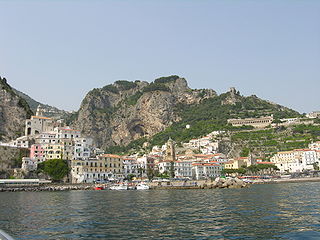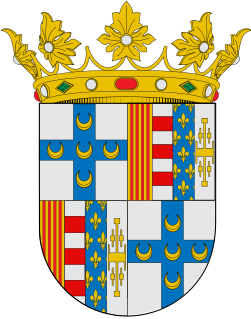
Amalfi is a town and comune in the province of Salerno, in the region of Campania, Italy, on the Gulf of Salerno. It lies at the mouth of a deep ravine, at the foot of Monte Cerreto, surrounded by dramatic cliffs and coastal scenery. The town of Amalfi was the capital of the maritime republic known as the Duchy of Amalfi, an important trading power in the Mediterranean between 839 and around 1200.

The Amalfi Coast is a stretch of coastline on the northern coast of the Salerno Gulf on the Tyrrhenian Sea, located in the Province of Salerno of southern Italy.

The Duchy of Gaeta was an early medieval state centered on the coastal South Italian city of Gaeta. It began in the early ninth century as the local community began to grow autonomous as Byzantine power lagged in the Mediterranean and the peninsula due to Lombard and Saracen incursions.

The Duchy of Amalfi or the Republic of Amalfi was a de facto independent state centered on the Southern Italian city of Amalfi during the 10th and 11th centuries. The city and its territory were originally part of the larger ducatus Neapolitanus, governed by a patrician, but it extracted itself from Byzantine vassalage and first elected a duke in 958. During the 10th and 11th centuries Amalfi was estimated to have a population of 50,000 -70,000 people. It rose to become an economic powerhouse, a commercial center whose merchants dominated Mediterranean and Italian trade for centuries before being surpassed and superseded by the other maritime republics of the North, like Pisa, Venice, and Genoa. In 1073, Amalfi lost its independence, falling to French Norman invasion and subsequently to Pisa in 1137.
Guaimar III was the Lombard prince of Salerno from around 994 to his death. Under his reign, Salerno entered an era of great splendour. Opulenta Salernum was the inscription on his coins. He made Amalfi, Gaeta and Sorrento his vassals and annexed much of Byzantine Apulia and Calabria.

Gisulf II was the last Lombard prince of Salerno (1052–1077).

Sicard was the Prince of Benevento from 832. He was the last prince of a united Benevento which covered most of the Mezzogiorno. On his death, the principality descended into civil war which split it permanently. He was the son and successor of the Spoletan Sico.

Manso I was the duke of Amalfi (966–1004) and prince of Salerno (981–983). He was the son of Duke Sergius I and the greatest independent ruler of Amalfi, which he controlled for nearly half a century. He is sometimes numbered Manso III.
John II was the duke of Amalfi from 1029 to 1069 with multiple interruptions. He was the son of Sergius II and Maria, sister of Pandulf IV of Capua. He was the last significant duke of Amalfi before the Norman conquest of 1073.
Manso II the Blind was the duke of Amalfi on three separate occasions: from 1028 to 1029, from 1034 to 1038, and from 1043 to 1052. He was the second son of Sergius II and Maria, sister of Pandulf IV of Capua. His whole ducal career consisted of wars with his brother, John II, over the throne. The Chronicon Amalfitanum is an important source for his reign.
Maria was ruling Duchess of Amalfi in co-regency with her sons twice: in 1028–29 and in 1034–39. During the reigns of her sons, she appears to have held the actual power.

The Lombard Principality of Salerno was a South Italian state, formed in 851 out of the Principality of Benevento after a decade-long civil war.
Marinus Sebastus was a scion of the dynasty of the Sergi and the Amalfitan family of the Capuano. He was a sebastos who was elected Duke of the Republic of Amalfi in 1096 in opposition to Norman suzerainty.

The maritime republics of the Mediterranean Basin were thalassocratic city-states which flourished in Italy and Dalmatia during the Middle Ages. The best known among the maritime republics are Venice, Genoa, Pisa, and Amalfi. Less known are Ragusa, Gaeta, Ancona, and Noli.
Sergius II was the Patrician and Duke of Amalfi, the son and successor of John I, who co-reigned with his father until the latter's death in 1007.

The Pactum Sicardi was a treaty signed on 4 July 836 between the Greek Duchy of Naples, including its satellite city-states of Sorrento and Amalfi, represented by Bishop John IV and Duke Andrew II, and the Lombard Prince of Benevento, Sicard. The treaty was an armistice ending a war between the Greek states and Benevento, during which the Byzantine Empire had not intervened on behalf of its subjects. It was supposed to last five years between the Lombard prince and the Neapolitans. It was a temporary armistice and was distinguished from other treaties such as Pactum Warmundi, which established temporary alliances.
Trofimena is a female saint canonised in the Roman Catholic church. Originally from the town of Patti in Sicily, the relics of Trofimena are venerated in the basilica in the town of Minori, Italy on the coast of Amalfi, southern Italy.
Manso was a Lombard viceduke (vicedux) who ruled the Duchy of Amalfi during the reign of Roger Borsa, the Norman Duke of Apulia. He is known only from his coins: large, copper follari bearing the inscription MANSO VICEDUX on the reverse. Irregular and poor in quality, mostly overstrikes of Salernitan coins, they were originally attributed to Manso of Salerno (981–83).

Rome is the capital city and a special comune of Italy. Rome also serves as the capital of the Lazio region. With 2,872,800 residents in 1,285 km2 (496.1 sq mi), it is also the country's most populated comune. It is the fourth most populous city in the European Union by population within city limits. It is the centre of the Metropolitan City of Rome, which has a population of 4,355,725 residents, thus making it the most populous metropolitan city in Italy. Rome is located in the central-western portion of the Italian Peninsula, within Lazio (Latium), along the shores of the Tiber. The Vatican City is an independent country inside the city boundaries of Rome, the only existing example of a country within a city: for this reason Rome has been often defined as capital of two states.

Ferdinand Chalandon was a French medievalist and Byzantinist.

Paris is the capital and most populous city of France, with an area of 105 square kilometres and an official estimated population of 2,140,526 residents as of 1 January 2019. Since the 17th century, Paris has been one of Europe's major centres of finance, diplomacy, commerce, fashion, science, as well as the arts. The City of Paris is the centre and seat of government of the Île-de-France, or Paris Region, which has an estimated official 2019 population of 12,213,364, or about 18 percent of the population of France. The Paris Region had a GDP of €709 billion in 2017. According to the Economist Intelligence Unit Worldwide Cost of Living Survey in 2018, Paris was the second most expensive city in the world, after Singapore, and ahead of Zurich, Hong Kong, Oslo and Geneva. Another source ranked Paris as most expensive, on a par with Singapore and Hong Kong, in 2018. The city is a major railway, highway, and air-transport hub served by two international airports: Paris-Charles de Gaulle and Paris-Orly. Opened in 1900, the city's subway system, the Paris Métro, serves 5.23 million passengers daily, and is the second busiest metro system in Europe after Moscow Metro. Gare du Nord is the 24th busiest railway station in the world, but the first located outside Japan, with 262 million passengers in 2015.













